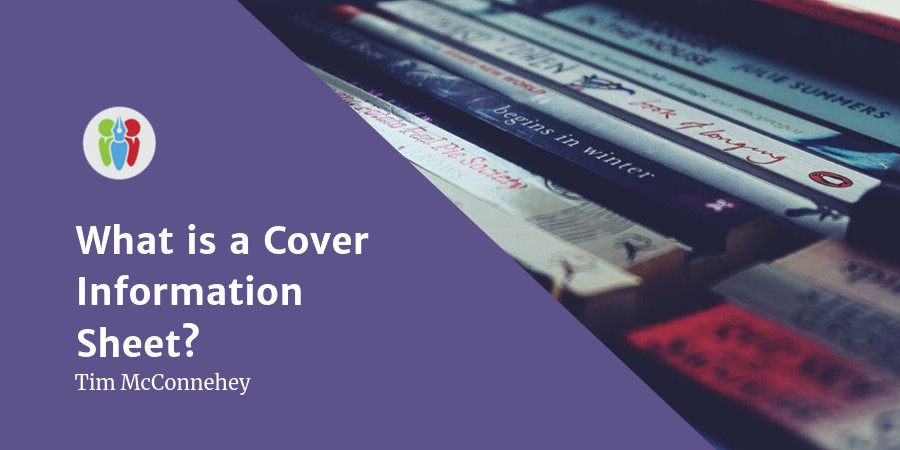Every reader has had a book cover catch their eye from the shelves of a bookstore, or even from a long list of Amazon search results. Sometimes all it takes is one glance. But how do you go from twinkle in your eye idea to reader grabbing cover design? Tim McConnehey, founder of Izzard Ink explains how the cover information sheet is central to taking your concept to completed commission.
What is a Cover Information Sheet?

Tim McConnehey founder of Izzard Ink
There's something magical about seeing your cover design for the first time. But I'm sure some of you are left wondering how it happened? What goes on behind the scenes to create those covers at major publishing houses? And how can independent authors align their design process with the major publishers?
Would you be surprised to learn that most of it comes down to research?
A book cover is the foundation of a successful marketing campaign. It is also a key opportunity for an author to showcase that they’ve given the same level of care to every detail in the publishing process, produced a quality book, earned praise from trusted reviewers, and at a glance, to stand out from the millions of books already on the market.
So how should authors and publishers accomplish those goals? What separates a top-notch design process from the do-it-yourself approach? What separates a general designer from a cover designer with bestseller experience, who could cost thousands? It is the research. A winning cover should be designed in the context of not only the author’s ideas, but the rest of the book’s marketing plan. That’s where a cover information sheet comes in.
The Cover Information Sheet
What is a cover information sheet (CIS)? It is a roughly three-page questionnaire that is used to collect information about a book, for use in the cover design process. This includes putting an author’s creative vision into words, to give the designer ideas to work from. But crucially, it also covers parts of the book’s marketing plan so the cover can include meet those five guidelines, and cater directly to the book’s target audience.
General Information
To get started, the CIS includes basic information liketitle, subtitle, author’s name, BISAC category (genre), and word count. Make sure to work with a designer takes the time to gather these basic elements.
Marketing
This info is absolutely key to cover design, and easily overlooked. How about your book’s subtitle? Does it use popular keywords? What about the tagline, brief description, and elevator pitch? A cover should convey all of that information at a mere glance, all with the target demographic and selling points in mind. Comparable titles give important clues as to what designs are already working for the expected audience. This is one of the reasons why covers can vary in price from $100 to $4,000+.
Author’s Vision
An author’s vision isn’t the only factor that’s important when designing a cover, but it certainly is an important element. The CIS will offer a chance to put that vision into words that a designer can use as a reference, including any ideas the authors has and what existing book covers they find appealing as inspiration.
The Homerun Review
Consider the sci-fi novel A Printer’s Choice, by W.L. Patenaude, as an example of a perfectly executed cover. The author worked with Izzard Ink Publishing and other professionals with backgrounds at major publishing houses. It took several weeks, but conveyed the mood of the book and met reader expectations for the sci-fi genre.
While the book was out for trade reviews, it earned a coveted “Starred Review” from Publishers Weekly, allowing the author to walk into just about any book store and arrange a signing. That review gave the author all the credibility he needed, but a sloppy cover could have still derailed everything. Instead, the review gave the designer the chance to showcase the credibility the book had already earned, by featuring it on the cover.
Self-publishing authors often struggle with getting a powerful review worth putting on the cover, and having a marketing team and cover designer working together provides a seamless solution to this problem. This is one of the benefits of working with a collaborative team of professionals, instead of handling each step separately. Inexperienced designers may not even consider the rest of the process, or what reviews are worth putting on the cover.
The Value of Multiple Cover Options
Investing in a serious designer will give authors a chance to choose from multiple cover options and then make further refinements to get the ideal cover. This is key for balancing marketing considerations with the author’s creative vision, and gives the author another level of input beyond saying ‘yes’ or ‘no’ to a single ‘take it or leave it’ option. A selection of covers, all of which meet the five guidelines, allows authors to have the final say on their cover while making sure all the marketing research plays a role.
Process and Experience
When authors try to design a cover themselves, it’s often based solely on their own personal vision for their book. And while that factors heavily into our design process, it’s just one piece of the puzzle. Likewise, a designer with minimal experience working on books might listen to an author’s ideas without giving any feedback, providing any context, or offering options.
All That for a Glance?
There’s too much riding on your cover’s ability to make the right impression at a glance to take shortcuts or hold back on cover design. It’s really about taking the time to do the research and putting the right process and structure in place, balancing creativity and marketing. An experienced book cover designer knows exactly how this is done.
Authors should understand, though, that these designers will charge enough to give themselves time to do that research properly and factor in other parts of the publishing process, ultimately offering a book cover that authors are proud to display and that readers are eager to open to the first page.
What Do You Need to Design the Perfect Cover? @izzardink #indieauthor #selfpublishing #IARTG #ASMRG #writingcommunity Share on XOVER TO YOU
How much research do you do for your cover design? Have you ever used a cover information sheet?
If you enjoyed this post, you might like these from the ALLi archive:
https://selfpublishingadvice.org/journey-to-the-perfect-book-cover/




